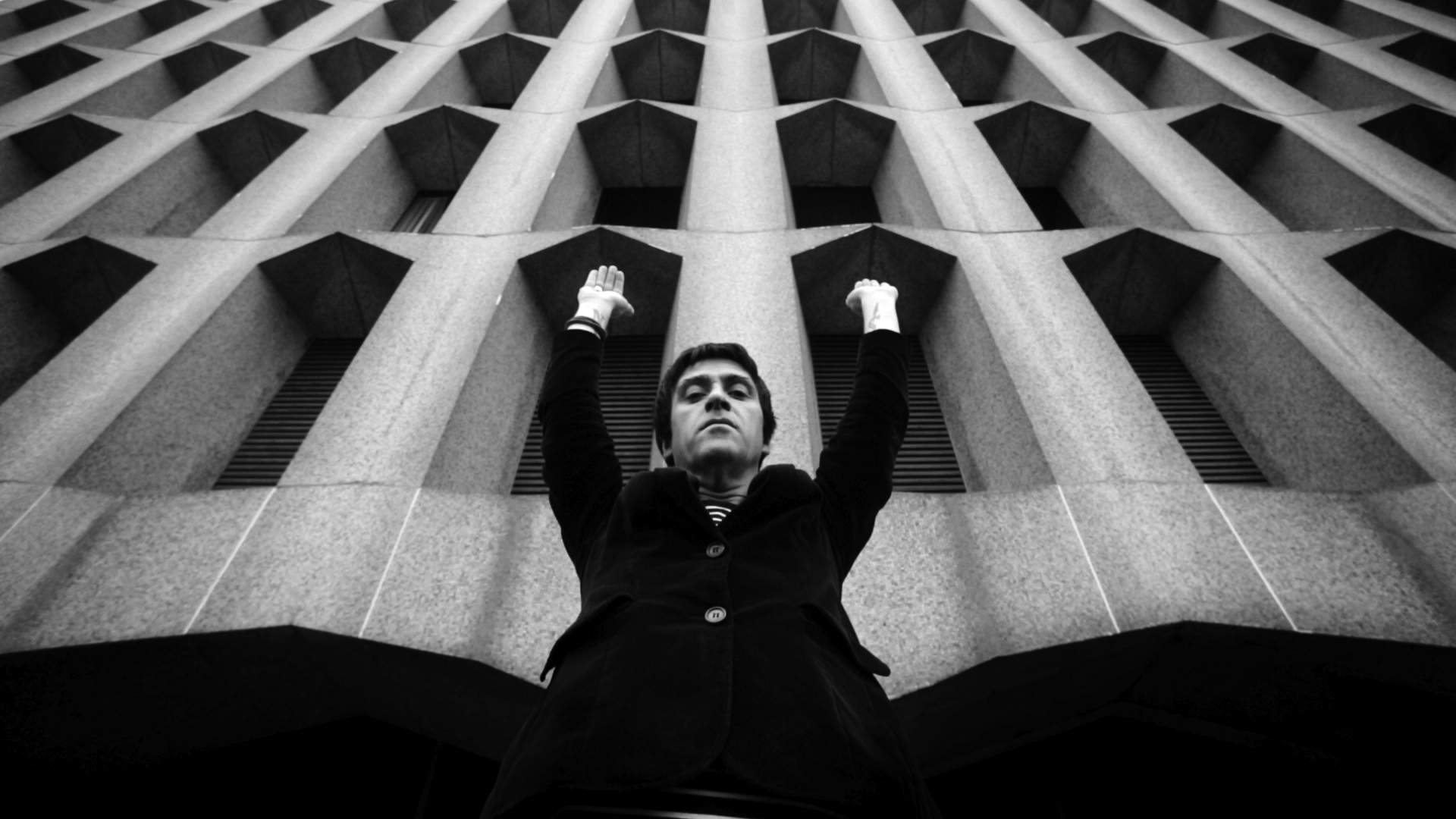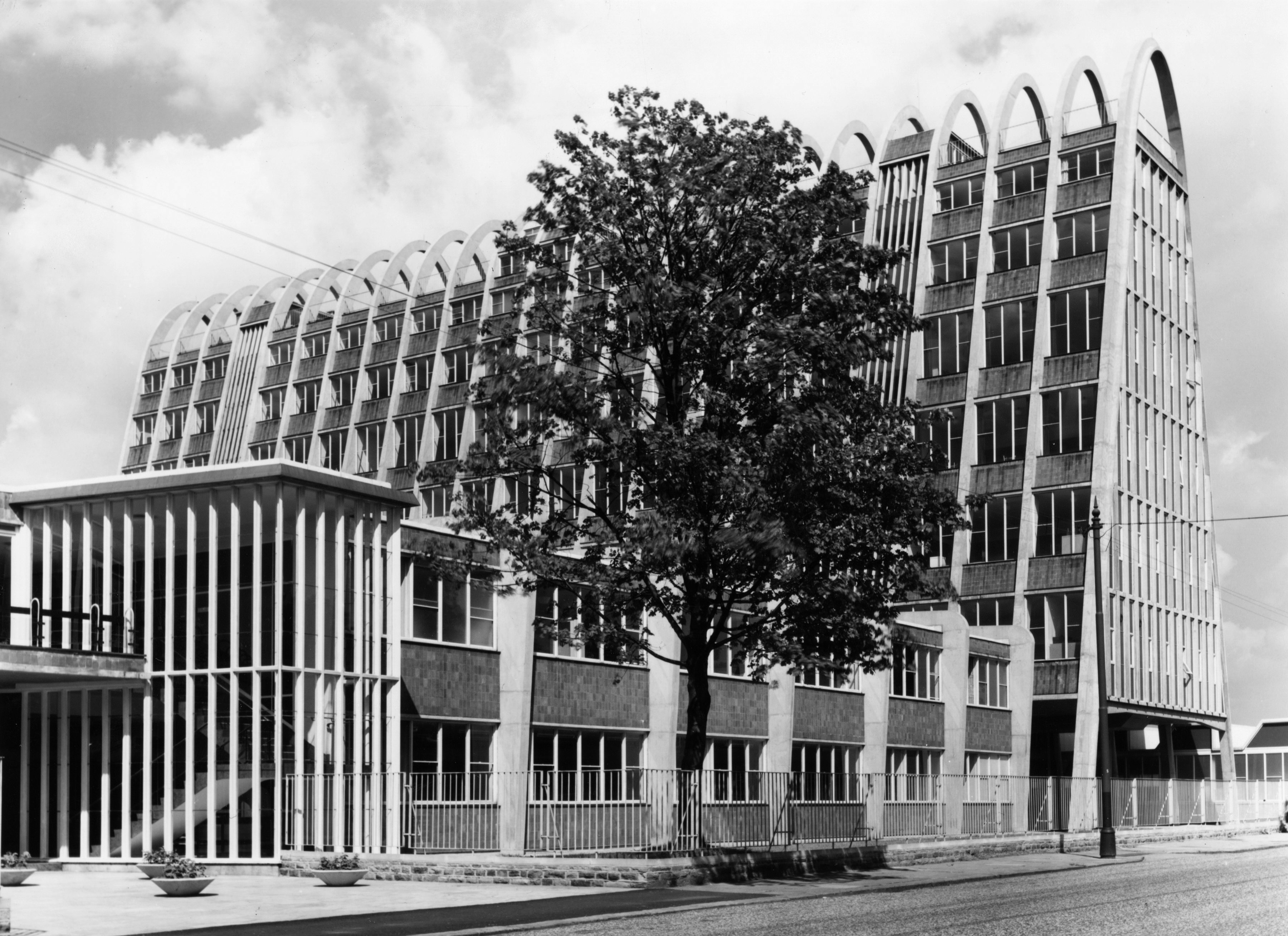How did you get involved with the Manchester Modernist Society?
I was aware of the society having bought their magazine, The Modernist, which is great. A fan sent me some copies and I wanted to know about the people behind it. Then last year I then met with Jack Hale, who runs the society. It’s a very unique endeavour – really interesting.
You grew up in Wythenshawe – largely built as a low-rise garden city. What was the house like where you grew up?
The first Modernist buildings I noticed would’ve been the Hulme Crescents, which were very new and quite imposing. I was always curious too about the Toast Rack [the Hollings Building at Manchester Metropolitan University by Leonard C Howitt].
My family were moved out to the suburbs of Wythenshawe in south Manchester from Ardwick Green in 1972, as part of the urban regeneration that demolished the small streets around the city centre and replaced them with commercial properties. Wythenshawe was known as the biggest council housing area in Europe and my family were one of the first to move into an estate of 200 houses.
Advertisement
Only a few houses had been completed when I moved there, so I lived on a giant building site for a long time. It was great for a kid, playing in partly built, empty houses. The houses were generic 70s brown-brick boxes with one main living room and three bedrooms [divided] by plasterboard. They had an indoor toilet though – a fancy step up from where I’d come from.

The Hollings Building at Manchester Metropolitan University
How did Modernist and Brutalist buildings influence you as you grew up?
My very first impressions as a child were formed in the late 60s. Because I grew up around the city centre, I remember Piccadilly Gardens very well and a lot of activity around there. The Piccadilly Hotel there was very modern and quite impressive at the time. The Umist buildings were new too, and I always really liked being around there, particularly in the early evenings. It was so open and new. Later in 1976 and 1977, the houses that had been built around Salford, Cheetham Hill and Collyhurst were the homes of disenchanted city kids who became the punks. One of the things that made them disenchanted was growing up in those areas. There was a need to assert individuality when you were living in those places, I suppose.
Many connect the architecture of Modernist council housing estates and the poverty found on them. Do you take issue with that association?
There was poverty on the council estates, there’s no denying that. There was, however, a sense of community and – before the fall of the Labour party and the trade unions – unity too. Everybody living closely together created a shared experience that was actually quite nice even if everyone was skint. I wouldn’t take issue with the association because it’s true.
One thing about the council estates was that families were connected by walkways that on the early estates they were known as ‘ginnels’. They were a good idea but could be a bit dangerous in the wrong areas.
In discussing the fate of the council estates you have to take into account the rise of the class A drug culture in the UK. It took things on estates to a whole new level of fear and misery and danger. That started in the 80s when the Tories got into power. What a coincidence.
Advertisement
Attitudes to modernist architecture have changed - it’s a good thing
Do you think the perception of Modernist architecture has shifted?
I’ve seen the attitudes to Modernist architecture change a lot. That’s a good thing and, although it seems surprising, it makes sense when you look at how boring and terribly generic a lot of the architecture became during the 1990s, particularly in the towns and suburbs. There’s much cheap brown brick that I’m guessing is supposed to look gentrified. Even the term ‘new builds’ is so dull. In the light of that, the Modernist tower blocks that were scorned for so long appear to have much more style; at least there’s a philosophy behind them. What’s more, some of those places are more spacious and better built. They were supposed to be the cheapest and nastiest things in the world.
What do you think of Postmodern architecture?
I like a lot of it. We’re living in a time when we can take the best of everything from the past and reimagine it. I personally like the classic Modernist style from America and how it’s influenced the Postmodernist architecture. I do like the Co-operative at 1 Angel Square in Manchester. I’ve seen a lot of beautiful modern things in Scandinavia, and I recently saw some great photographs of architecture in Tel Aviv that I didn’t know about.
From the Hacienda, to Tom Bloxham’s Home nightclub to the Canal Street quarter, much of Manchester’s regeneration during the 1990s seemed to rely on embracing countercultural movements. How did this affectmind the way the city developed?
If you were of a certain age and mind-set in the last 20 years in Manchester then you will have a sense of the counterculture, and that influenced things. The Northern Quarter is a success story commercially, although it doesn’t strike me as having a significant amount of new buildings as such. I might be wrong, but it seems to have redone most of the places that were already there with a contemporary aesthetic. Some of the old warehouse conversions are very good particularly around what’s called the ‘Upper Northern Quarter’. Jackson’s warehouse and the Green Quarter have a good atmosphere. I’m not so sure about Ancoats. I suspect they might have got the economics wrong somehow.
What are your favourite Modernist buildings in Manchester, and in the UK in general?
I like The Midland Hotel [Oliver Hill, 1933] in Morecambe and the Arcadia Works [now Greater London House, by ME Collins, OH Collins and AG Porri] in London. All the obvious ones I guess; the Daily Express building on Fleet Street. I used to love the one on Great Ancoats street in Manchester but that got ruined. The Hexagon Tower in Blackley, north Manchester [Richard Seifert & Partners, 1971] is great and features in a video I did for my song called New Town Velocity. That video is a psychogeographical view of Greater Manchester. It starts off on the estate I grew up on and has some great buildings in it. I was trying to show my environment in a way that it isn’t usually shown, which is usually Victorian.
Your most recent album, Playland, includes a song about a building. Is it right that you wrote it about the CIS building in Manchester?‘Dynamo’ is a song that I wrote as a love affair to a building. I was wandering around New York and came across a new building. I stood looking up at it with the royal blue sky behind it and it was awe-inspiring. I had a similar experience at the CIS building in Manchester – weird I know – and because I was recording by the Thames I saw the Gherkin a lot so I put them all together. I wanted to write a love song without falling into the usual sentiments, so I did it about a building: ‘You’re a living thing, some kind of fantasy. Secrets appear and touch minds, you are invited’. You have to write about something I guess.
What do you think about the government’s stance on architecture? Do you believe design is in the coalition’s thoughts when it comes to, say, new housing?
I honestly don’t know enough to comment, although my instinct tells me it isn’t young families who get the most benefit from the building programmes. There is another song on Playland called ‘Little King’, which was inspired by a conversation I had with a property developer; an entrepreneur telling me about buying up land everywhere to throw up these new builds and car parks too.
I was appalled by the entitlement and sheer arrogance of it. I don’t believe all of the land should be for sale. I’ve been to a lot of cities in the UK and most of the new houses I’ve seen look shit.
 The Architects’ Journal Architecture News & Buildings
The Architects’ Journal Architecture News & Buildings






Leave a comment
or a new account to join the discussion.